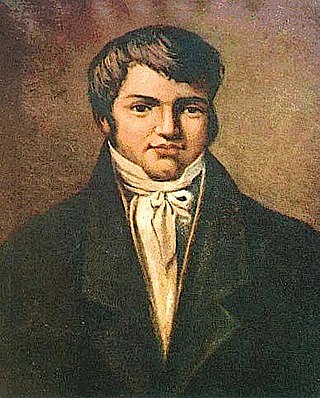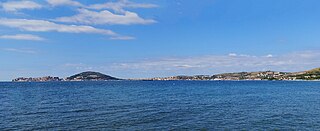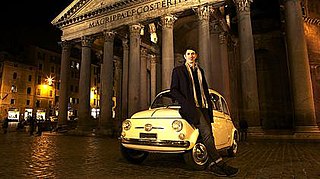
Fra Diavolo, is the popular name given to Michele Pezza, a guerrilla leader who resisted the French occupation of Naples, proving an "inspirational practitioner of popular insurrection". Pezza figures prominently in folk lore and fiction. He appears in several works of Alexandre Dumas, including The Last Cavalier: Being the Adventures of Count Sainte-hermine in the Age of Napoleon, not published until 2007 and in Washington Irving's short story "The Inn at Terracina".

Gaeta is a city in the province of Latina, in Lazio, Italy. Set on a promontory stretching towards the Gulf of Gaeta, it is 120 kilometres from Rome and 80 km (50 mi) from Naples.

The statue of Laocoön and His Sons, also called the Laocoön Group, has been one of the most famous ancient sculptures since it was excavated in Rome in 1506 and put on public display in the Vatican Museums, where it remains today. The statue is very likely the same one that was praised in the highest terms by Pliny the Elder, the main Roman writer on art, who attributed it to Greek sculptors but did not say when it was created. The figures in the statue are nearly life-sized, with the entire group measuring just over 2 m in height. The sculpture depicts the Trojan priest Laocoön and his sons Antiphantes and Thymbraeus being attacked by sea serpents.

Ponza is the largest island of the Italian Pontine Islands archipelago, located 33 km (21 mi) south of Cape Circeo in the Tyrrhenian Sea. It is also the name of the commune of the island, a part of the province of Latina in the Lazio region.
Formia is a city and comune in the province of Latina, on the Mediterranean coast of Lazio, Italy. It is located halfway between Rome and Naples, and lies on the Roman-era Appian Way.

Itri is a small city and comune the province of Latina, Lazio, central Italy.

Fondi is a city and comune in the province of Latina, Lazio, central Italy, halfway between Rome and Naples. As of 2017, the city had a population of 39,800. The city has experienced steady population growth since the early 2000s, though this has slowed in recent years.

Agesander was one, or more likely, several Greek sculptors from the island of Rhodes, working in the first centuries BC and AD, in a late Hellenistic "baroque" style. If there was more than one sculptor called Agesander they were very likely related to each other. The very important works of the groups of Laocoön and His Sons, in the Vatican Museums, and the sculptures discovered at Sperlonga are both signed by three sculptors including an Agesander.

The province of Latina is a province in the Lazio region of Italy. Its provincial capital is the city of Latina. It is bordered by the provinces of Frosinone to the northeast and by the Metropolitan City of Rome Capital to the northwest.

Terracina is an Italian city and comune of the province of Latina, located on the coast 56 km (35 mi) southeast of Rome on the Via Appia. The site has been continuously occupied since antiquity.

The Pontine Islands are an archipelago in the Tyrrhenian Sea off the coast of Lazio region, Italy. The islands were collectively named after the largest island in the group, Ponza. The other islands in the archipelago are Palmarola, Zannone, and Gavi to the northwest and Ventotene and Santo Stefano to the southeast. These two groups are separated by 22 nautical miles (41 km). From Sabaudia-Cape Circeo peninsula to Zannone the distance is 12 nautical miles (22 km), while Ventotene faces Gaeta. The minimum distance between Santo Stefano and the isle of Ischia is 22 nautical miles (41 km). In ancient times they were called Pontiae (Πόντιαι).

The Duchy of Gaeta was an early medieval state centered on the coastal South Italian city of Gaeta. It began in the early ninth century as the local community began to grow autonomous as Byzantine power lagged in the Mediterranean and the peninsula due to Lombard and Saracen incursions.

Monte San Biagio is a town and comune in the province of Latina, in southern Lazio (Italy). It is located on the slope of a hill part of the Monti Ausoni. Until 1862 it was known as Monticello.

André Durand is a Canadian painter working in the European Hermetic tradition. He is influenced by artists such as Rubens, Titian, Michelangelo and Velázquez.

The Sperlonga sculptures are a large and elaborate ensemble of ancient sculptures discovered in 1957 in the grounds of the former villa of the Emperor Tiberius at Sperlonga, on the coast between Rome and Naples. As reconstructed, the sculptures were arranged in groups around the interior of a large natural grotto facing the sea used by Tiberius for dining; many scholars believe he had the sculptures installed. The groups show incidents from the story of the Homeric hero Odysseus, and are in Hellenistic "baroque" style, "a loud, full-blown baroque", but are generally thought to date to the early Imperial period.

The Pasquino Group is a group of marble sculptures that copy a Hellenistic bronze original, dating to ca. 200–150 BCE. At least fifteen Roman marble copies of this sculpture are known. Many of these marble copies have complex artistic and social histories that illustrate the degree to which improvisatory "restorations" were made to fragments of ancient Roman sculpture during the 16th and 17th centuries, in which contemporary Italian sculptors made original and often arbitrary and destructive additions in an effort to replace lost fragments of the ancient sculptures.

The Rome–Formia–Naples railway—also called the Rome–Naples Direttissima in Italian –is part of the traditional main north-south trunk line of the Italian railway network. It was opened in 1927 as a fast link as an alternative to the existing Rome–Naples via Cassino line, significantly reducing journey times. High-speed trains on the route use the parallel Rome–Naples high-speed railway, which was partially opened in December 2005, and fully in December 2009.

Treasures of Ancient Rome is a 2012 three-part documentary written and presented by Alastair Sooke. The series was produced by the BBC, and originally aired in September 2012 on BBC Four. In the documentary Sooke sets out to "debunk the myth that Romans didn't do art and were unoriginal". This is based on the view that Romans heavily incorporated Greek style in their art, and hence produced nothing new or original. Sooke has received some criticism from the media because there is no consensus among academics on this topic, and hence no 'myth' exists in the first place.
Amyclae or Amyclanus was a Greek city of Magna Graecia on the coast of Latium, between Tarracina and Caieta, which had ceased to exist in the time of Pliny, but had left the name of Sinus Amyclanus to the part of the coast on which it was situated. Its foundation was ascribed to a band of Laconians who had emigrated from the city of the same name near Sparta; and a strange story is told by Pliny and Servius of the inhabitants having been compelled to abandon it by the swarms of serpents with which they were infested.
The Via Flacca was a Roman road along the western coast of Latium, Italy. It was built under censor Lucius Valerius Flaccus around 184 BC. Parts of it have recently been renovated as a trekking route.























